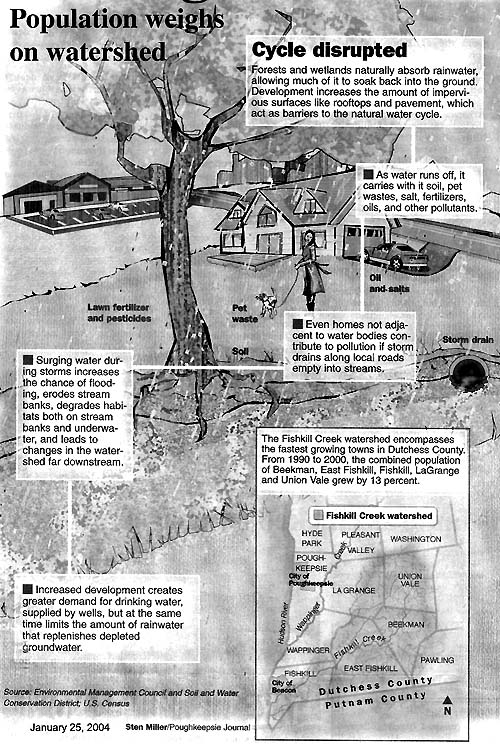
January 25, 2004
Population weighs on watershed
Development tampers with Fishkill Creek
By David Burns
For the Poughkeepsie Journal

Population weighs on watershed
Development tampers with Fishkill Creek
By David Burns
For the Poughkeepsie Journal

At 193.1 square miles, the Fishkill Creek watershed encompasses about 20 percent of Dutchess County, flowing through 11 Dutchess and three Putnam County municipalities.
The network of streams and groundwater that drains into the Fishkill Creek provides drinking water for thousands of residents, water for industry and business and recreation for anglers and boaters.
As the population of Southern Dutchess surges, understanding the role of the Fishkill Creek watershed and ensuring its resources are available to future generations has become increasingly important.
As Fishkill Creek Watershed land uses have evolved over the last 60 years, the natural water balance -- and the cycle that replenishes water supplies critical to both wildlife and humans -- has been altered.
According to Dutchess County Environmental Management Council land use data, residential land uses increased 15.2 percent between 1995 and 2000. Homes mostly replaced farmland, which decreased approximately 21 percent in the same period.
Natural forest cover and wetlands have been replaced with roads, driveways, parking lots and buildings.
It is this widespread, but piecemeal change to the landscape -- and not any single source of pollution -- that represents the greatest threat to the long-term health of the watershed.
Absorption blocked
Forests and wetlands naturally absorb rainwater, allowing much of it to percolate back into the ground. Hard surfaces like pavement and rooftops -- commonly called impervious surfaces -- increase the amount of rainfall that flows over land and reduce the amount of rainfall that percolates into the soil to recharge our wells and streams.
Impervious surfaces interrupt the natural water cycle.
Unable to soak into the earth, rainwater rushes into streams, leading to flooding, erosion, damage to wildlife habitats and changes to channels far downstream.
As water flows over paved surfaces, it also collects soil, pet wastes, salt, fertilizers, oils and other pollutants -- which are carried into nearby streams.
Even if your house does not directly border a stream or river, rainwater flows down your street into a storm drain. Storm sewers often carry this runoff from your neighborhood directly to the nearest body of water, along with dirt and pollutants.
The Department of Environmental Conservation and the research organization Hudsonia have documented impaired portions of the Fishkill Creek's main stem.
Several lakes in the watershed have also been degraded because aquatic plants are growing at accelerated rates, changing the ecosystem and limiting people's use. This happens when nutrients from roads, lawns and septic systems enter the lakes and sediment from eroding streams and road runoff gradually makes the lakes more shallow and better suited for plant growth.
Finally, besides the surface water problems, a portion of southern Dutchess groundwater is contaminated by organic chemicals such as PCE, TCE and MTBE through improper disposal of industrial solvents and gasoline spills.
However, all is not bad in the Fishkill Watershed. Hudsonia researchers also demonstrated a variety of habitats in the Fishkill Creek supporting many types of fish -- from upland cold water species like the slimy sculpin and brook trout, to slow-moving species like banded killifish and largemouth bass.
In addition, groups and government have recently taken a greater interest in highlighting the watershed's resources, addressing its threats and planning for its future.
Clean water critical
The stakes are clear. The region needs enough clean water for its residents, businesses and wildlife now and into the future.
Planning to ensure an adequate water supply requires a comprehensive approach to documenting the magnitude of potential watershed impairment and strategies to fix problems and prevent future damage.
The volunteer Fishkill Creek Watershed Planning Committee, through its in-progress Natural Resource Management Plan for the Fishkill Creek Watershed, is attempting to sustain and guide the planning process.
Ultimately, the actions of citizens living in the Fishkill watershed will determine the fate of the water's quality and availability.
David Burns is watershed coordinator for the Dutchess County Environmental Management Council, an advisory body to the Dutchess County Legislature.
Resources
For information, visit the Fishkill Creek Watershed Planning Committee's Web group at http://groups.yahoo.com/group/Fishkillwatershed.
| Watershed Home | Media Menu |